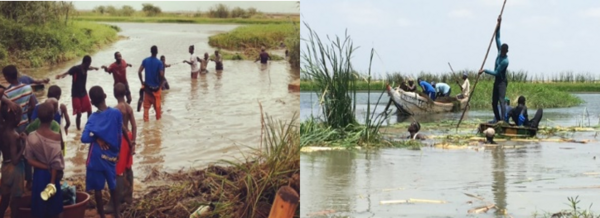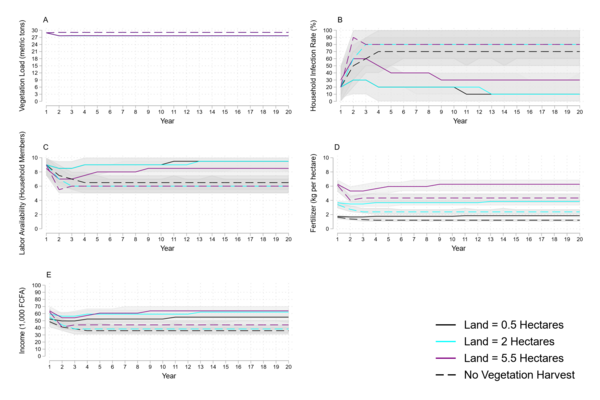Prosocial Behavior and Breaking Poverty-Disease Traps
We observed prosocial behavior in the form of regular, voluntary community engagement in the vegetation removal process after we educated community members on the expected public health benefits of this intervention (Fig. 1). Nonetheless, relying purely on voluntary labor to clear the vegetation will almost surely result in suboptimal vegetation clearing and higher prevalence of Schistosoma infections relative to the condition where they perceive and act on private benefits. By converting the public nuisance, aquatic vegetation, into a profitable agricultural input, we provide a private economic incentive to maintain cleared waterways, generating public health co-benefits along with higher private incomes. We expect that communicating these private benefits to community members will increase vegetation removal relative to communicating the public health benefits alone, which could help marginalized communities escape poverty-disease traps. Our modeling efforts do indeed support the notion that this intervention can rescue communities from poverty-disease traps.
 Fig. 1. Voluntary community engagement in the vegetation removal process after we educated community members on the expected public health benefits of this intervention.
Fig. 1. Voluntary community engagement in the vegetation removal process after we educated community members on the expected public health benefits of this intervention.
To explore how clearing vegetation removal could help communities escape poverty-disease traps, we developed a bioeconomic model that combines a model of household behavior with a model of schistosomiasis disease ecology. Households optimally decide how to spend their time and resources producing crops, harvesting vegetation, applying fertilizer, and consuming goods. When households make their decisions, we use these values in a model of schistosomiasis disease ecology that determines if infection risk increases, decreases, or stays the same. Households then realize their new level of schistosomiasis infection and then re-optimize how they allocate their time and resources. We repeat this process 20 times to simulate the system for 20 years tracking household decisions, incomes, and infection. We find that local conversion of vegetation to compost changes the feedbacks among interlinked disease, aquatic and agricultural systems, reducing schistosomiasis infection and increasing incomes relative to the current status quo, in which villagers rarely remove vegetation. Aquatic vegetation removal disrupts the poverty-disease trap, and the result is healthier people, more productive labor, cleaner water, more productive agriculture, and higher incomes.
 Figure 2. Median vegetation load, infection rate, labor availability, fertilizer use, and income for simulations with and without vegetation harvest. Panel A plots the median aquatic vegetation stock (population) in metric tons across 1,000 20-year simulations for three different household land endowments with (solid lines) and without (dashed lines) vegetation harvest. Aquatic vegetation load represents the size of the snail habitat within the village water access point used by the household. Shaded areas represent the 5-95 percent centered confidence band. Based on scale and precision, not all shaded areas are visible. Panel B shows the median household infection rate (the number of infected individuals divided by total number of household members). Panel C reports median labor availability from the 10-person household size maximum. Panel D displays median fertilizer use in kgs per hectare, and Panel E reports the median income in FCFA1,000. Medians and percentiles are within each land endowment each time period across the 1,000 simulations.
Figure 2. Median vegetation load, infection rate, labor availability, fertilizer use, and income for simulations with and without vegetation harvest. Panel A plots the median aquatic vegetation stock (population) in metric tons across 1,000 20-year simulations for three different household land endowments with (solid lines) and without (dashed lines) vegetation harvest. Aquatic vegetation load represents the size of the snail habitat within the village water access point used by the household. Shaded areas represent the 5-95 percent centered confidence band. Based on scale and precision, not all shaded areas are visible. Panel B shows the median household infection rate (the number of infected individuals divided by total number of household members). Panel C reports median labor availability from the 10-person household size maximum. Panel D displays median fertilizer use in kgs per hectare, and Panel E reports the median income in FCFA1,000. Medians and percentiles are within each land endowment each time period across the 1,000 simulations.
For more information, see Rohr et al. 2023.